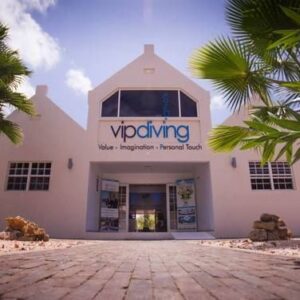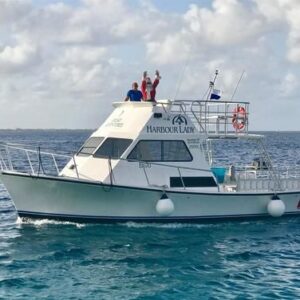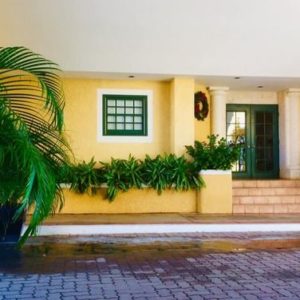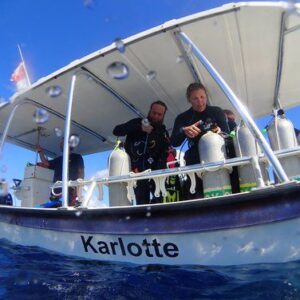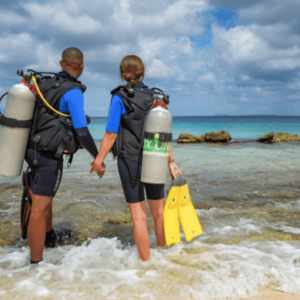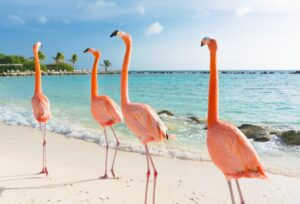Bonaire is known as the shore capital of the Caribbean! Bonaire’s calm and crystalline underwater world offers spectacular scenery and unparalleled visibility. The untouched white beaches are surrounded by a shimmering turquoise sea and is a sight unchanged since privateers ruled these waters and land three centuries ago. Bonaire is the first Caribbean Island to protect the surrounding seas with a marine park created as part of the Stichting Nationale Parken Bonaire (STINAPA) in 1962.
As one of three Dutch Caribbean islands, along with better known Aruba and Curacao, it is approximately fifty miles off the coast of Venezuela. The island is comprised of natural habitats that includes reefs and beaches to deserts and rainforests. The island boasts over eighty-five dive sites with fifty-four of them easily accessible from shore. More than 350 species of fish and fifty-seven species of coral can be found among the reefs of Bonaire.
GETTING THERE
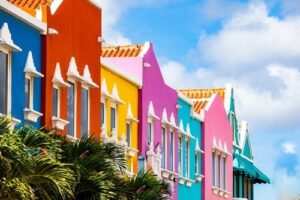
Flights on United, Delta and American fly direct flights from New York, Houston, Atlanta, and Miami.
GETTING AROUND
Car Rentals: Car rentals are available from well-known, reliable rental agencies.
Taxi service: Taxis are always available. +5997178100
Rentals: Golf carts, motorcycles, and bicycles are available.
Ferries: If planning day trips to Klein Bonaire, a ferry is the best option.
GOOD TO KNOW
Country: Dutch Caribbean Island
Time Zone: Atlantic Standard Time (AST)
Primary Language: English but Papiamentu, the island’s native language, Spanish and Dutch are also spoken on Bonaire.
Currency: US Dollar
Cell Phone Service: Be sure to check with your cell phone carrier to see if they offer an international plan or roaming fees apply.
Voltage: 127 V/50 Hertz
Passport and Visa: A valid passport is needed but most visitors will not need a visa to enter Bonaire.
Hurricane Details: Bonaire lies outside of “Hurricane Alley” to the south.
DIVE CONDITIONS
Water Temperature: 80-86F
Water Visibility: 40-100 feet
When to Go: Bonaire offers a consistently warm and sunny climate so diving can be done 365 days a year.
Diving Difficulty: Beginner – Advanced
TOP DIVE SITES IN BONAIRE
Bonaire caters to the diving enthusiast! Listed are some of the very best that Bonaire can offer divers:
- 1000 Steps (20-100 feet): 67 steps lead divers from the road to the beach and it is said that it seems like 1000 steps on the way back, hence the name of this site. The star coral at this site has grown into high-rising pagoda like structures. The hollow cores provide homes for many reef creatures. Whale sharks, Hawksbill turtles and manta rays are often spotted here.
- Alice in Wonderland (30-100 feet): The double reef can be experienced at this dive. The south has complex reef structures and a variety of unique corals in the shallows for divers to experience.
- Andrea 1 and 2 (20-100 feet): Andrea 1 and 2 are perfect for beginner divers and snorkelers. Divers can explore anemones and soft corals that provide hiding places for both predators and prey. The blue parrot fish, the midnight, and the rainbow parrotfish as well as seahorses can be found here.
- Bari Reef (30-100 feet): Bari Reef is rated number 1 for fish diversity. This site has over 300 species sighted and surveyed. Steps lead divers directly into the water from the pier which makes it a very convenient and easy dive.
- Forest (25-100 feet): Gorgonian fans can be found in the shallows and in the deeper water. Large colonies of fern-like black coral make this a unique dive. A large cave at 75 feet provides a home for the green moray, loggerhead turtles and nurse sharks.
- Hilma Hooker (25-100 feet): Hilma Hooker is a large, impressive, intentional wreck dive with great visibility and easily accessible by shore. It was created with the sinking of the 236-foot freighter in 1984. Located at the beginning of the double reef system, the top of the ship is found lying starboard at 60 feet under the water and the mast at 99 feet. For those looking to see how corals have developed on an artificial site, this site is perfect.
- Karpata (20-100 feet): Karpata is located at the end of the one-way section on the coastal road and is a popular shore dive. Panoramic views make this a wonderful place for wide-angle photography. Huge ship anchors embedded in the coral provide a great photo backdrop. Although a harder dive from shore, it is well worth it. The reef slopes vertically 130 feet to the sand. This is a good site to see pelagic out in the blue water.
- Munk’s Haven (30-100 feet): Munk’s Haven is located on the west side of Klein Bonaire. On the shallows terrace, divers can experience coral and sand with many burrowing creatures, such as yellowhead jawfish and sand tile fish. The hard-to-find sand tile fish build dens by carrying small pieces of rubble onto a pile.
- No Name (30-100 feet): Known as one of the most popular dives on Klein Bonaire, this dive is named for the No Name Beach that lies directly in front of it. In the sandy bottom, yellowhead jawfish poke their heads out of holes in the coral rubble. The blackish sail fin blennies can be found here. This is a beautiful place to spend the day enjoying both the diving site and the picturesque sandy beach.
- Nukove (15-100 feet): Nukove is for the advanced diver and located on the northwest of Washington Slagbaai National Park. Divers will experience some of the most pristine coral found on the island as well as some larger marine life.
- Oil Slick Leap (20-80 feet): This is a recommended boat dive. Proposed as an oil storage terminal, this site was named Oil Slick Leap. Divers can expect to see large schools of barracuda here.
- Ol’ Blue (20-80 feet): Located just north of 1000 Steps, divers will enjoy listening to the musical sounds of the coral rocks as they wash to shore. Sharks have been spotted here so divers must pay attention to their depths.
- Playa Funchi (15-100 feet): Located in Washington Slagbaai National Park, the shallows at this site are loaded with smaller fish that love to interact with divers and snorkelers. Horse-eye jacks can be spotted out in the blue water here.
- Red Slave (20-80 feet): This site is recommended for advanced divers. Red Slave is located adjacent to the second set of slave huts. Divers can encounter horse-eye jacks, turtles, baitfish, and bigeye scads.
- Salt Pier (15-50 feet): This dive is accessible by boat, but prior permission is required if accessed by shore. The pillars are encrusted with sponges and corals. This dive offers easy entry for new divers and is great for photography. With the salt terminal overhead, large schools of fish congregate in the shadows and makes for excellent wide-angle opportunities.
- Tori’s Reef (20-100 feet): Located directly across from the outflow from the salt works, divers will encounter strands of elkhorn coral on a sandy bottom. The diversity of fish that can be encountered here makes it #2 in the Caribbean for fish diversity.
- Wayaka (30-100 feet): Wayaka offers divers a new site where little diving has occurred. Located within the confines of Washington Slagbaai National Park, Wayaka is home to larger marine life.
- White Hole (15-100 feet): The White Hole is home to tarpons, turtles, rays, and the occasional shark. Also known as East coast diving, this site lies off Lac Bay.
- Windsock (20-80 feet): Windsock is a popular place for picnics and relaxing after a day of diving. Divers can encounter rays and turtles. This site is perfect for snorkelers and beginner divers.
TOP ATTRACTIONS IN BONAIRE
- Bara Di Karta: Bara di Karta water well is a ten-minute hike to a beautiful scenic view of a large part of the island. Kralendijk and Klein Bonaire can be seen to the west. And to the east, the airport, the salt pans, Lac mangroves, the rough east coast, and in the distance the lighthouse cave can be seen.
- Botanical Garden: Manuel will provide information about the plantations on a tour of the Botanical Garden. Botanical Garden also offers Permaculture, Medicinal Herbs and Organic Herbs.
- Brandaris: At 784 feet, the Brandaris is the highest peak on Bonaire. It is in the Washington Slagbaai National Park. The Subi Brandaris Trail is a 45-minute hike that leads to the Brandaris. This climb has some difficulty but the view from the top is an incredible reward for making the trip. Visitors can see the island of Curacao, the Santa Ana Hill in the Paraguana Peninsula of Venezuela and the mountain range south of Puerto Cabello, Venezuela on clear days.
- Caves: There are many caves on Bonaire, and several are accessible to visitors. Some caves are hidden and filled with water. They are a crucial part of the island’s ecosystem. The caves filled with water are used to help the farmers grow crops and serve as a water source for feral goats and donkeys. Bats spend the day hanging upside down in the caves until sunset when they leave in search of food.
- Donkey Sanctuary Bonaire: Marina Melis and her husband Ed Koopman established a donkey sanctuary on Bonaire for sick, wounded, and orphaned donkeys in 1993. The primary objective of the sanctuary is to offer a sheltered, protected life to any donkeys in need.
- Downtown Kralendijk: Krelendijk, Dutch for coral reef, is the capital city and main port of the island. This lively and colorful Caribbean town center hosts great food and shopping.
The slogan on Bonaire license plates is “Diver’s Paradise.” Divers have the unique experience and freedom of repeatedly diving favorite sites due to the accessibility of each site from the shore. The reef is a short swim from the shore! Sites are clearly marked and easily identifiable, each marked with a large yellow rock with the site name painted on it. Drivers need to drive down the road until a yellow marker is seen. It is perfect for those who love the freedom and independence of diving on their own schedule.
The beauty of the island, the warm tropical climate, and the best protected and diverse reef in the Caribbean makes Bonaire a top choice of divers!

